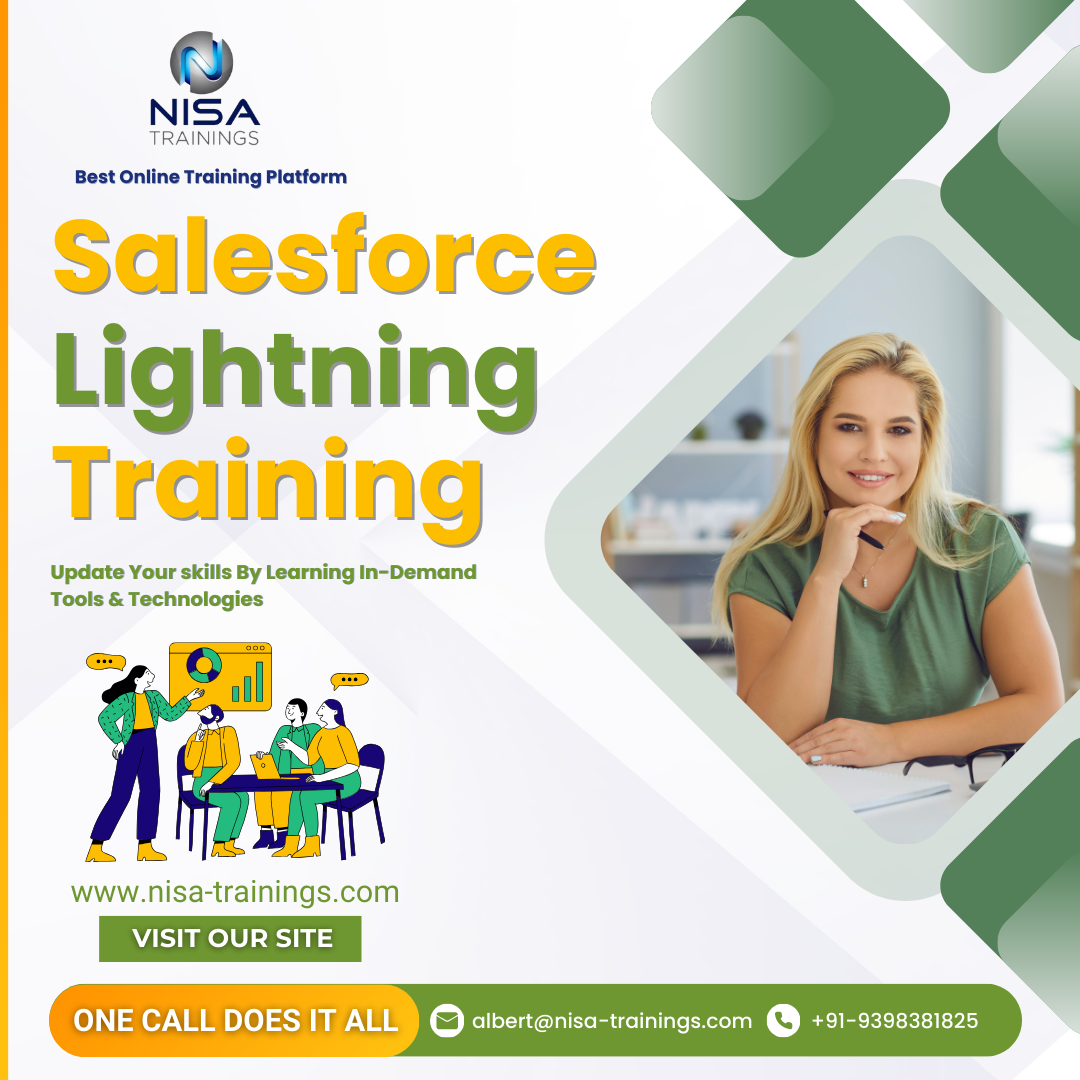Salesforce Lightning Training
Salesforce Lightning Training focuses on equipping learners with the skills needed to build, configure, and optimize Salesforce applications using the Lightning Experience. Lightning is Salesforce’s modern user interface (UI) and app development framework that enhances productivity and customizability.

Why should you choose Nisa For Salesforce Lightning Training?
Nisa Trainings is the best online training platform for conducting one-on-one interactive live sessions with a 1:1 student-teacher ratio. You can gain hands-on experience by working on near-real-time projects under the guidance of our experienced faculty. We support you even after the completion of the course and happy to clarify your doubts anytime. Our teaching style at Nisa Trainings is entirely hands-on. You’ll have access to our desktop screen and will be actively conducting hands-on labs on your desktop.
Job Assistance
If you face any problem while working on Salesforce Lightning Course, then Nisa Trainings is simply a Call/Text/Email away to assist you. We offer Online Job Support for professionals to assist them and to solve their problems in real-time.
The Process we follow for our Online Job Support Service:
- We receive your inquiry for Online Job
- We will arrange a telephone call with our consultant to grasp your complete requirement and the tools you’re
- If our consultant is 100% confident in taking up your requirement and when you are also comfortable with our consultant, we will only agree to provide service. And then you have to make the payment to get the service from
- We will fix the timing for Online Job Support as mutually agreed by you and our consultant.
Course Information
Salesforce Lightning Training
Duration: 25 Hours
Timings: Weekdays (1-2 Hours per day) [OR] Weekends (2-3 Hours per day)
Training Method: Instructor Led Online One-on-One Live Interactive
Sessions.
COURSE CONTENT :
1. Introduction to Salesforce Lightning
- Overview of Salesforce Lightning:
- What is Salesforce Lightning?
- Differences between Salesforce Classic and Lightning Experience
- Benefits of Lightning for users and developers
- Navigating the Lightning Experience:
- Lightning Home Page
- App Launcher and Lightning Apps
- Global Actions and Chatter
2. Salesforce Lightning Components
- Introduction to Lightning Component Framework:
- Aura Components
- Lightning Web Components (LWC) overview
- Understanding Lightning Component Architecture
- Client-side and server-side controllers
- Lightning Data Service
- Building Lightning Components:
- Setting up a Salesforce Developer Org
- Writing custom Lightning components
- Embedding components in Lightning pages
3. Customizing Lightning Experience
- Using the Lightning App Builder:
- Customizing pages: Home, Record, and App pages
- Drag-and-drop interface for layouts
- Assigning Lightning pages to users
- Lightning UI Customizations:
- Compact layouts
- List views
- Related lists
- Branding with Salesforce Lightning:
- Themes and branding settings
4. Process Automation with Lightning
- Automating Business Processes:
- Flow Builder in Lightning
- Workflow Rules vs. Process Builder
- Approval Processes
- Advanced Automation with Flows:
- Screen Flows
- Record-Triggered Flows
- Scheduled Flows
- Integrating automation with Lightning Pages
5. Lightning Web Components (LWC) Development
- Introduction to Lightning Web Components:
- Benefits of LWC over Aura components
- Key LWC concepts: Shadow DOM, JavaScript, and HTML templates
- Setting up the Development Environment:
- Salesforce CLI and Visual Studio Code
- Installing the Salesforce Extension Pack
- Building LWC Applications:
- Creating and deploying LWCs
- Using Apex with LWCs for server-side logic
- Handling events and communication between components
- Advanced LWC Topics:
- Data Binding
- SLDS (Salesforce Lightning Design System)
- Testing and debugging LWCs
6. Lightning Data Management
- Understanding Data Management in Lightning:
- Importing and exporting data
- Creating and managing custom objects and fields
- Lightning Data Service (LDS):
- Accessing Salesforce data with LDS
- Best practices for data handling in Lightning
7. Integration in Lightning
- Salesforce Lightning with APIs:
- Using REST and SOAP APIs
- Integrating external systems with Lightning components
- Event-Driven Architecture:
- Platform Events
- Pub/Sub model in Lightning
8. Analytics and Reporting in Lightning
- Building Reports and Dashboards:
- Report Builder in Lightning
- Dynamic Dashboards
- Lightning Table and Chart components
- Using Einstein Analytics (Tableau CRM):
- Overview of Einstein Analytics features
- Building predictive dashboards in Lightning
9. Lightning for Mobile
- Salesforce Mobile App:
- Customizing the mobile experience
- Building mobile-friendly Lightning pages
- Optimizing Lightning components for mobile
10. Best Practices and Advanced Topics
- Transitioning from Classic to Lightning:
- Migration strategy
- Managing adoption and training for users
- Performance optimization in Lightning:
- Reducing load times for Lightning components
- Handling governor limits
- Security in Lightning:
- Locker Service
- Sharing rules and field-level security
